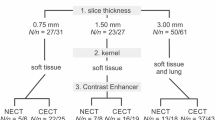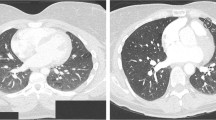Abstract
Purpose
To evaluate whether a computer-aided vessel-suppression system improves lung nodule detection in routine clinical settings.
Materials and methods
We used computer software that automatically suppresses pulmonary vessels on chest CT while preserving pulmonary nodules. Sixty-one chest CT images were included in our study. Three radiologists independently read either standard CT images alone or both computer-aided CT and standard CT images randomly to detect a pulmonary nodule ≥ 4 mm in diameter. After an interval of at least 15 days to avoid recall bias, the three radiologists interpreted the counterpart images of the same patients. The reference standard was decided by an expert panel. The primary endpoint was sensitivity. The secondary endpoint was interpretation time.
Results
The average sensitivity improved with computer-aided CT (72% for standard CT vs. 84% for computer-aided CT, p = 0.02). There was no difference in the false-positive rate (21% for both standard CT and computer-aided CT, p = 0.98). Although the average reading time was 9.5% longer for computer-aided plus standard CT compared with standard CT alone, the difference was not significant (p = 0.11).
Conclusion
Vessel-suppressed CT images helped radiologists to improve the sensitivity of pulmonary nodule detection without compromising the false-positive rate.




Similar content being viewed by others
References
The national lung screening trial research team. Reduced lung-cancer mortality with low-dose computed tomographic screening. N Engl J Med. 2011;365:395–409.
Hirose T, Nitta N, Shiraishi J, Nagatani Y, Takahashi M, Murata K. Evaluation of computer-aided diagnosis (CAD) software for the detection of lung nodules on multidetector row computed tomography (MDCT): JAFROC study for the improvement in radiologists' diagnostic accuracy. Acad Radiol. 2008;15:1505–12.
Kozuka T, Matsukubo Y, Kadoba T, Oda T, Suzuki A, Hyodo T, et al. Efficiency of a computer-aided diagnosis (CAD) system with deep learning in detection of pulmonary nodules on 1-mm-thick images of computed tomography. Jpn J Radiol. 2020. https://doi.org/10.1007/s11604-020-01009-0.
Lo SB, Freedman MT, Gillis LB, White CS, Mun SK. Journal club: Computer-aided detection of lung nodules on CT with a computerized pulmonary vessel suppressed function. AJR Am J Roentgenol. 2018;210:480–8.
Wagner AK, Hapich A, Psychogios MN, Teichgraber U, Malich A, Papageorgiou I. Computer-aided detection of pulmonary nodules in computed tomography using ClearReadCT. J Med Syst. 2019;43:58.
Matsumoto S, Ohno Y, Aoki T, Yamagata H, Nogami M, Matsumoto K, Yamashita Y, Sugimura K. Computer-aided detection of lung nodules on multidetector CT in concurrent-reader and second-reader modes: a comparative study. Eur J Radiol. 2013;82:1332–7.
Foti G, Faccioli N, D'Onofrio M, Contro A, Milazzo T, Pozzi MR. Evaluation of a method of computer-aided detection (CAD) of pulmonary nodules with computed tomography. Radiol Med. 2010;115:950–61.
MacMahon H, Austin JH, Gamsu G, Herold CJ, Jett JR, Naidich DP, et al. Guidelines for management of small pulmonary nodules detected on CT scans: a statement from the Fleischner Society. Radiology. 2005;237:395–400.
Fleiss JL, Tytun A, Ury HK. A simple approximation for calculating sample sizes for comparing independent proportions. Biometrics. 1980;36:343–6.
Hosny A, Parmar C, Quackenbush J, Schwartz LH, Aerts HJWL. Artificial intelligence in radiology. Nat Rev Cancer. 2018;18:500–10.
Mayo RC, Leung J. Artificial intelligence and deep learning—radiology’s next frontier? Clin Imaging. 2018;49:87–8.
Matsumoto M, Koike S, Kashima S, Awai K. Geographic distribution of CT, MRI and PET devices in Japan: a longitudinal analysis based on national census data. PLoS ONE. 2015;10(5):e0126036.
Scholten ET, Horeweg N, de Koning HJ, Vliegenthart R, Oudkerk M, Mali WP, et al. Computed tomographic characteristics of interval and post screen carcinomas in lung cancer screening. Eur Radiol. 2015;25:81–8.
Cai J, Xu D, Liu S, Cham MD. The added value of computer-aided detection of small pulmonary nodules and missed lung cancers. J Thorac Imaging. 2018;33:390–5.
Beyer F, Zierott L, Fallenberg EM, Juergens KU, Stoeckel J, Heindel W, et al. Comparison of sensitivity and reading time for the use of computer-aided detection (CAD) of pulmonary nodules at MDCT as concurrent or second reader. Eur Radiol. 2007;17:2941.
Author information
Authors and Affiliations
Corresponding author
Ethics declarations
Conflict of interest
The authors declare that they have no conflict of interest.
Ethical approval
This study was approved by the local ethics review board and informed consent was waived due to the retrospective nature of this study.
Additional information
Publisher's Note
Springer Nature remains neutral with regard to jurisdictional claims in published maps and institutional affiliations.
About this article
Cite this article
Takaishi, T., Ozawa, Y., Bando, Y. et al. Incorporation of a computer-aided vessel-suppression system to detect lung nodules in CT images: effect on sensitivity and reading time in routine clinical settings. Jpn J Radiol 39, 159–164 (2021). https://doi.org/10.1007/s11604-020-01043-y
Received:
Accepted:
Published:
Issue Date:
DOI: https://doi.org/10.1007/s11604-020-01043-y




